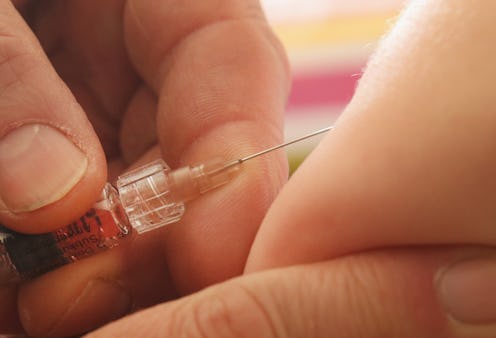Life
Could A Vaccine For This STI Be On The Way?
Sexually transmitted diseases and infections are terrifying. They linger at the top of my greatest fears list somewhere between dying alone and the cancellation of Orange Is The New Black. With condom and other contraceptive use and regular testing people are able to have piece of mind and practice safe sex, yay. Well, this may get even easier to do. Scientists may have discovered a vaccine for chlamydia! As a receiver of the HPV vaccine I'm all on board for this. This news is coming on the tail end of the news about the invention of STI detecting condoms. Scientists are becoming the best wingmen/women in the world of safe sex. I mean I'd like to think that Bill Nye is in his lab somewhere working on something to get us all safely laid.
This isn't the first time researchers have attempted to create a vaccine for chlamydia; however, the most recent attempt before now didn't go so well. According to The Verge, scientists during the '60s tested chlamydia vaccines on people in developing countries, including young children. There are a lot of reasons why this test wasn't cool already — and it gets even worse: Some of the people who were given the vaccine ended up being more likely to develop chlamydia than those who weren't. After the results became clear, the popularity of testing chlamydia vaccines on humans dropped after that — and the researchers never determined why the vaccine didn't work the way they thought it was going to.
Researchers decided to recreate their test, this time on mice. To recreate the experiment they gave their test mice a dose of live or dead chlamydia bacteria, followed by a dose of live chlamydia bacteria. The mice who were previously injected with the dead bacteria were more likely to become infected. Just like the people who had been vaccinated in the 1960's. The question, then, became: Why?
A specific white blood cell, T lymphocite, was especially responsive to chlamydia, according to an immune system analysis. T cells are essential to human immunity and scan the body for infections and irregularities. According to study co-author Ulrich von Adrian via The Verge, "T cells can become cells that fight the infection — protective T cells — or regulatory T cells, which protect Chlamydia" — that is, these naturally occurring white blood cells can take on one of two different roles. It turns out that they behave differently to live or dead chlamydia bacteria, becoming regulatory cells in response to the dead bacteria, rather than ones that would fight the infection.
Therefore, when the live chlamydia bacteria was injected on the second time around, the T cells were less likely to fight it off — the dead chlamydia bacteria had suppressed the mouse's immune system. The good news for scientists was that the immune system was recognizing dead chlamydia bacteria, even if it wasn't fighting it.
The next step was creating a vaccine. Get ready for experiment time, everyone.
Next, scientists created nano-particles, bio-degradable plastic materials used in things like dissolvable sutures, and attached them directly to the vaccine. Realizing that all cells, including dead bacterial cells, carry a negative charge, scientists gave the nano-particles a positive charge and they stuck right on. What did this do? Well, the T-cells didn't really want anything to do with the vaccine and didn't "regulate" the dead chlamydia cells.
It gets even cooler, too: Since chlamydia generally infects mucous membranes including the uterus, scientists decided to administer the vaccine as a nasal spray, and it worked! The mice were protected for around six months. This doesn't mean this vaccine can prevent infection, but it can shorten it and lessen its severity.
These trials haven't been done on humans yet, however, the mice used were "humanized" — that is, they had had human immune cells grafted to the insides of their bodies. Researchers are hoping that vaccine testing on humans will be available in the next few years.
Why is a vaccine so important? According to the CDC, there are up to three million cases of chlamydia per year, mostly in young women. Most of time chlamydia has no symptoms, but can still be transmitted from one person to another via oral, vaginal, or anal sex or between mother and child during birth or while breastfeeding. Although it can be treated with antibiotics, if left untreated it can lead to severe reproductive problems and blindness. If symptoms are present they can be pain in the lower abdomen, testicle, pelvis, vagina or during urination or sexual intercourse; discharge from the penis, vaginal bleeding, abnormal vaginal discharge, spotting or fever.
Yeah, no thanks.
Let's get it, science.
Images: Giphy (3)
